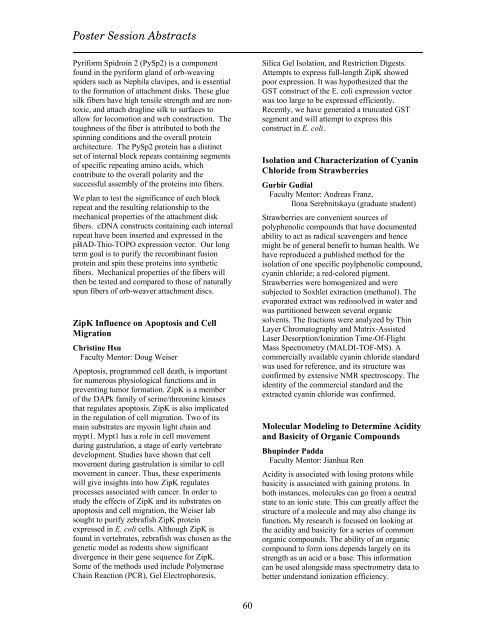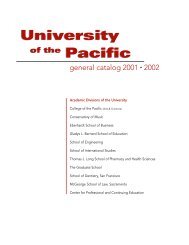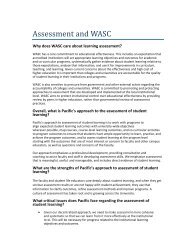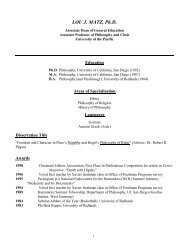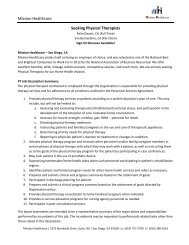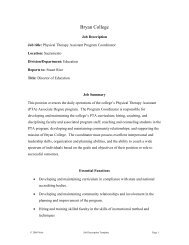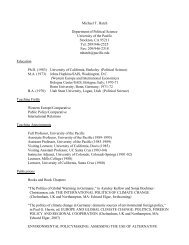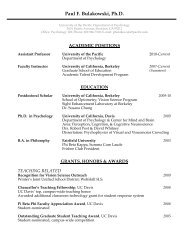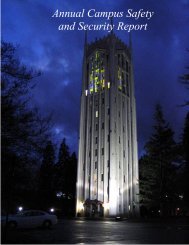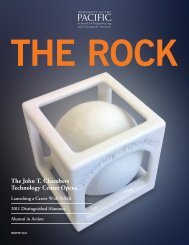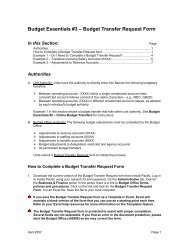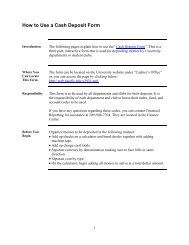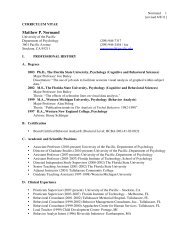purcc 2012 - University of the Pacific
purcc 2012 - University of the Pacific
purcc 2012 - University of the Pacific
Create successful ePaper yourself
Turn your PDF publications into a flip-book with our unique Google optimized e-Paper software.
Poster Session Abstracts<br />
Pyriform Spidroin 2 (PySp2) is a component<br />
found in <strong>the</strong> pyriform gland <strong>of</strong> orb-weaving<br />
spiders such as Nephila clavipes, and is essential<br />
to <strong>the</strong> formation <strong>of</strong> attachment disks. These glue<br />
silk fibers have high tensile strength and are nontoxic,<br />
and attach dragline silk to surfaces to<br />
allow for locomotion and web construction. The<br />
toughness <strong>of</strong> <strong>the</strong> fiber is attributed to both <strong>the</strong><br />
spinning conditions and <strong>the</strong> overall protein<br />
architecture. The PySp2 protein has a distinct<br />
set <strong>of</strong> internal block repeats containing segments<br />
<strong>of</strong> specific repeating amino acids, which<br />
contribute to <strong>the</strong> overall polarity and <strong>the</strong><br />
successful assembly <strong>of</strong> <strong>the</strong> proteins into fibers.<br />
We plan to test <strong>the</strong> significance <strong>of</strong> each block<br />
repeat and <strong>the</strong> resulting relationship to <strong>the</strong><br />
mechanical properties <strong>of</strong> <strong>the</strong> attachment disk<br />
fibers. cDNA constructs containing each internal<br />
repeat have been inserted and expressed in <strong>the</strong><br />
pBAD-Thio-TOPO expression vector. Our long<br />
term goal is to purify <strong>the</strong> recombinant fusion<br />
protein and spin <strong>the</strong>se proteins into syn<strong>the</strong>tic<br />
fibers. Mechanical properties <strong>of</strong> <strong>the</strong> fibers will<br />
<strong>the</strong>n be tested and compared to those <strong>of</strong> naturally<br />
spun fibers <strong>of</strong> orb-weaver attachment discs.<br />
ZipK Influence on Apoptosis and Cell<br />
Migration<br />
Christine Hsu<br />
Faculty Mentor: Doug Weiser<br />
Apoptosis, programmed cell death, is important<br />
for numerous physiological functions and in<br />
preventing tumor formation. ZipK is a member<br />
<strong>of</strong> <strong>the</strong> DAPk family <strong>of</strong> serine/threonine kinases<br />
that regulates apoptosis. ZipK is also implicated<br />
in <strong>the</strong> regulation <strong>of</strong> cell migration. Two <strong>of</strong> its<br />
main substrates are myosin light chain and<br />
mypt1. Mypt1 has a role in cell movement<br />
during gastrulation, a stage <strong>of</strong> early vertebrate<br />
development. Studies have shown that cell<br />
movement during gastrulation is similar to cell<br />
movement in cancer. Thus, <strong>the</strong>se experiments<br />
will give insights into how ZipK regulates<br />
processes associated with cancer. In order to<br />
study <strong>the</strong> effects <strong>of</strong> ZipK and its substrates on<br />
apoptosis and cell migration, <strong>the</strong> Weiser lab<br />
sought to purify zebrafish ZipK protein<br />
expressed in E. coli cells. Although ZipK is<br />
found in vertebrates, zebrafish was chosen as <strong>the</strong><br />
genetic model as rodents show significant<br />
divergence in <strong>the</strong>ir gene sequence for ZipK.<br />
Some <strong>of</strong> <strong>the</strong> methods used include Polymerase<br />
Chain Reaction (PCR), Gel Electrophoresis,<br />
Silica Gel Isolation, and Restriction Digests.<br />
Attempts to express full-length ZipK showed<br />
poor expression. It was hypo<strong>the</strong>sized that <strong>the</strong><br />
GST construct <strong>of</strong> <strong>the</strong> E. coli expression vector<br />
was too large to be expressed efficiently.<br />
Recently, we have generated a truncated GST<br />
segment and will attempt to express this<br />
construct in E. coli.<br />
Isolation and Characterization <strong>of</strong> Cyanin<br />
Chloride from Strawberries<br />
Gurbir Gudial<br />
Faculty Mentor: Andreas Franz,<br />
Ilona Serebnitskaya (graduate student)<br />
Strawberries are convenient sources <strong>of</strong><br />
polyphenolic compounds that have documented<br />
ability to act as radical scavengers and hence<br />
might be <strong>of</strong> general benefit to human health. We<br />
have reproduced a published method for <strong>the</strong><br />
isolation <strong>of</strong> one specific poylphenolic compound,<br />
cyanin chloride; a red-colored pigment.<br />
Strawberries were homogenized and were<br />
subjected to Soxhlet extraction (methanol). The<br />
evaporated extract was redissolved in water and<br />
was partitioned between several organic<br />
solvents. The fractions were analyzed by Thin<br />
Layer Chromatography and Matrix-Assisted<br />
Laser Desorption/Ionization Time-Of-Flight<br />
Mass Spectrometry (MALDI-TOF-MS). A<br />
commercially available cyanin chloride standard<br />
was used for reference, and its structure was<br />
confirmed by extensive NMR spectroscopy. The<br />
identity <strong>of</strong> <strong>the</strong> commercial standard and <strong>the</strong><br />
extracted cyanin chloride was confirmed.<br />
Molecular Modeling to Determine Acidity<br />
and Basicity <strong>of</strong> Organic Compounds<br />
Bhupinder Padda<br />
Faculty Mentor: Jianhua Ren<br />
Acidity is associated with losing protons while<br />
basicity is associated with gaining protons. In<br />
both instances, molecules can go from a neutral<br />
state to an ionic state. This can greatly affect <strong>the</strong><br />
structure <strong>of</strong> a molecule and may also change its<br />
function. My research is focused on looking at<br />
<strong>the</strong> acidity and basicity for a series <strong>of</strong> common<br />
organic compounds. The ability <strong>of</strong> an organic<br />
compound to form ions depends largely on its<br />
strength as an acid or a base. This information<br />
can be used alongside mass spectrometry data to<br />
better understand ionization efficiency.<br />
60


